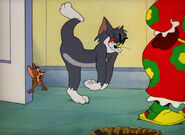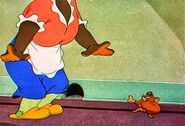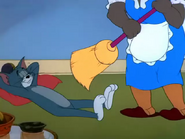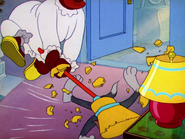(I don't force her into being a villain, I just say she and Jerry are enemies, not possible enemies.) Tag: Undo |
m (Reverted edits by Grandfather Joe (talk) to last revision by RRabbit42) Tag: Rollback |
||
| Line 6: | Line 6: | ||
|voiced by = [[wikipedia:Lillian Randolph|Lillian Randolph]] (original)<br>[[Wikipedia:Thea Vidale|Thea Vidale]] (dubbed versions) |
|voiced by = [[wikipedia:Lillian Randolph|Lillian Randolph]] (original)<br>[[Wikipedia:Thea Vidale|Thea Vidale]] (dubbed versions) |
||
|friends = [[Tom Cat|Tom]], [[Lightning Cat|Lightning]] (formerly) |
|friends = [[Tom Cat|Tom]], [[Lightning Cat|Lightning]] (formerly) |
||
| − | |enemies = [[Jerry Mouse|Jerry]], [[Tom Cat|Tom]] (formerly), [[Butch]], [[Lightning Cat|Lightning]], [[Topsy Cat|Topsy]] |
+ | |enemies = [[Jerry Mouse|Jerry]] (possibly), [[Tom Cat|Tom]] (formerly), [[Butch]], [[Lightning Cat|Lightning]], [[Topsy Cat|Topsy]] |
|family = [[Tom Cat]] (pet) |
|family = [[Tom Cat]] (pet) |
||
|relatives = Aunt Harriet (mentioned, not heard or seen in The Million Dollar Cat). |
|relatives = Aunt Harriet (mentioned, not heard or seen in The Million Dollar Cat). |
||
Revision as of 18:21, 19 December 2020
Mammy Two Shoes (also known as Mammy, Mammy Two-Shoes, or Dinah in the 1940s Tom and Jerry comics) is a recurring disappeared in 19 of MGM's Tom and Jerry cartoons. She is a heavy-set, middle-aged African-American woman who often has to deal with the mayhem generated by the lead characters, but whether she is the owner of the home or merely the house-keeper is never really made clear. She is based on the "Mammy" archetype that was prevalent throughout the U.S. in the 19th and early 20th century.
As a partially-seen character, she was famous for never showing her head and face (although it is briefly visible in Saturday Evening Puss and Part Time Pal). Mammy's appearances have often been edited out, dubbed, or re-animated as a slim white woman in television broadcasts, since her character is a mammy archetype now often regarded as racist.
Bio
Personality
Appearance
With dark brown skin (later changed to an ivory-colored skin tone) she is distinguished by her usual, sleeveless dress with frills in the shoulders, a white apron with frills in the trim, old, yellow socks (often seen with some kind of suspender holding it up), and red slippers. The color of her attire often changes, but the pieces remain virtually the same. These colors are yellow, orange, green, blue, and red. She is usually seen holding a broom. She also wears a red polka dot bandana on her head.
She is of mid-stature with dark skin, slightly rotund with a large bust and thick hands.
Theatrical Tom and Jerry cartoons
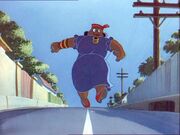
Mammy Two Shoes, in a scene from Saturday Evening Puss.
Mammy first appeared in Puss Gets the Boot, the first Tom and Jerry cartoon (except Tom was called "Jasper"). She always referred to Tom as his given name Thomas and almost always used "is" in conjunction with a pronoun ("is you" and "I is"). The character went on to make many appearances through 1952's Push-Button Kitty. William Hanna and Joseph Barbera initially portrayed Mammy as the maid of the house, with the real owners unknown to the viewers. Later, Hanna and Barbera seemed to suggest, through dialogue and occasional behavior, that the house was Mammy's own.
Censorship, discontinuation, and callbacks
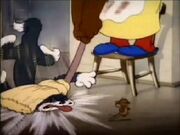
Mammy Two Shoes attacking Tom.
Director Gene Deitch stated that the "retiring" of Mammy's character was one of the changes that he felt he needed to make for the 13 shorts produced by Rembrandt Films.[1]
MGM Animation/Visual Arts, under the supervision of Chuck Jones, created replacement characters for Mammy in the Tom and Jerry cartoons featuring her for television. These versions used rotoscoping techniques to replace Mammy on-screen with either a stocky white woman (in most shorts) or a thin white woman (in Saturday Evening Puss); Randolph's voice on the soundtracks was replaced by an Irish-accented (or generic young adult in Puss) voice performed by June Foray.[2]
Three years after Turner Entertainment acquired Tom & Jerry from MGM, the cartoons featuring Mammy were re-recorded to remove Mammy Two Shoes' use of potentially offensive dialect. Lillian Randolph's voice was dubbed over by Thea Vidale. The re-recorded versions of the cartoons would air on Turner's Cartoon Network-related cable channels, and have at times turned up on DVD. However, some European TV showings of these cartoons, especially the UK, as well as the US DVD release of Tom and Jerry Spotlight Collection, Warner Bros. Home Entertainment Academy Awards Animation Collection, and Tom and Jerry: The Deluxe Anniversary Collection and the US DVD and Blu-ray releases of Tom and Jerry Golden Collection, retain Randolph's original voice. The Region 2 Complete Collectors Edition DVD boxset has Vidale's voice on the first DVD and Randolph in a number of the episodes after that (such as A Mouse in the House and Mouse Cleaning). As of 2011, most cartoons that featured Mammy-Two Shoes are rarely, if ever, aired on Cartoon Network and Boomerang. They are also unavailable on the Boomerang Streaming service. However, some cartoons such as The Lonesome Mouse and Mouse Cleaning were already rarely seen due to scenes that are already controversial. This even affects cartoons such as Puss N' Toots and The Mouse Comes to Dinner, in which Mammy-Two Shoes makes small, unimportant cameos. This hurts the latter more as the episode is already edited to remove her due to Jerry dressing up as an Indian.
A white woman named "Mrs. Two Shoes" appeared in some episodes of Tom and Jerry Tales. She had most aspects of Mammy Two Shoes' personality, a similar look, and a similar name.
Appearances
| No. | Title | Released |
|---|---|---|
| 1 | Puss Gets the Boot | February 10, 1940 |
| 2 | The Midnight Snack | July 19, 1941 |
| 4 | Fraidy Cat | January 17, 1942 |
| 5 | Dog Trouble | April 18, 1942 |
| 6 | Puss N' Toots | May 30, 1942 |
| 10 | The Lonesome Mouse | May 22, 1943 |
| 18 | The Mouse Comes to Dinner | May 5, 1945 |
| 28 | Part Time Pal | March 15, 1947 |
| 32 | A Mouse in the House | August 30, 1947 |
| 36 | Old Rockin' Chair Tom | September 18, 1948 |
| 38 | Mouse Cleaning | December 11, 1948 |
| 39 | Polka-Dot Puss | February 26, 1949 |
| 40 | The Little Orphan | April 30, 1949 |
| 48 | Saturday Evening Puss | January 14, 1950 |
| 53 | The Framed Cat | October 21, 1950 |
| 58 | Sleepy-Time Tom | May 26, 1951 |
| 61 | Nit-Witty Kitty | October 6, 1951 |
| 67 | Triplet Trouble | April 19, 1952 |
| 70 | Push-Button Kitty | September 6, 1952[3] |
Major appearances
- The Lonesome Mouse - She's tricked by Tom's and Jerry's truce.
- Part Time Pal - She is tormented by a drunk Tom.
- Old Rockin' Chair Tom - Mammy's longest onscreen appearance. She takes a cat named Lightning.
- Sleepy-Time Tom - She keeps an eye on Tom if he's sleeping on the job.
- Push-Button Kitty - She orders a robocat called Mechano.
Gags
- Been constantly afraid of Jerry (or mice in general) and jumping to the nearest high spot such as a chair or the balcony.
- Pulling up the skirt, often pulling up, comically, many layers of skirts with distinct patterns.
- Easily losing her temper with Tom's shenanigans.
Gallery
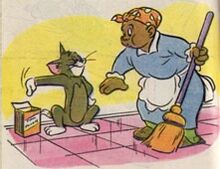
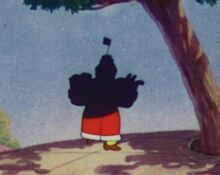
A Silhouette of mammy’s head
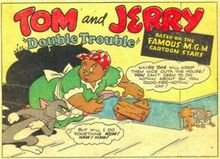
Another tom and jerry comic that reveals Mammy’s face
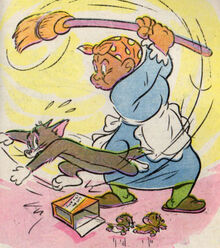
Mammy’s full appearance featured in a comic book
Trivia
- In Saturday Evening Puss, When Mammy Too Shoes dashes home to punish Tom and his Friends for throwing a party, her face is briefly shown once. This is the only instance her face is seen.
- Although Mammy two shoes face was a mystery in the show, she fully appeared with her face in the comics and storybooks.

